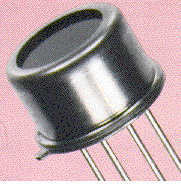

Infrared Detector Products
|
 |
| Servo Corporation has been involved with the various aspects of thermal detection application since 1946. Currently we are the leading supplier of thermal detectors to both the railroads for implementation in wheel bearing fault detection systems and to the aerospace industry for use in satellite Earth sensor assemblies. Servo's experience with thermal detectors includes thermistor bolometers based on high work function (TCR) oxide material and pyroelectric effect in ferroelectric material. Specific products include: |
|
About Thermistor Detectors
About Pyroelectric Detectors
|
Thermistor DetectorsThe thermistor detector is a thermal detector where the absorption of optical or infrared energy leads to a temperature rise. Since the thermistor has a very large negative temperature coefficient of about 4%/oC, a large voltage responsivity results when the detector is appropriately biased. The thermistor detector can also be used over the entire wavelength range of UV to far IR since the temperature rise is dependent on the energy absorbed and not the photon wavelength directly. Servo has been manufacturing thermistor bolometer IR detectors for nearly 50 years. Many thousands of devices been produced. The broad band optical (from UV to far IR wavelengths) and electrical response (from dc), as well as inherent ruggedness, have made this the detector of choice in many classical remote sensing applications. These include Earth horizon sensors for satellite attitude determination, Earth Resources Monitoring, non-contact IR thermometry and various industrial applications. In operation, the incident optical power causes an instantaneous change in the temperature of the element, thus changing its resistance. Until recently, these detectors have only been fabricated using a labor intensive ceramic technology where thin flakes of the thermistor material were bonded to substrates. The Model 1350 and Model 1375 Thermistor detectors are examples of detectors using this technology. The device performance parameters in these detectors such as responsivity, noise and response time, are very dependent on operator skill and experience, and processing conditions. Servo has developed a manufacturing method whereby the detectors are produced with modern semiconductor processing techniques. The core of the process is the ability to sputter deposit the active thermistor material onto suitable substrates while retaining it's high TCR. These films are deposited from a single target consisting of hot pressed Nickel, Cobalt and Manganese oxides. Processes to form the production of sputtering targets as well as delineation of the films have been developed and are being utilized at Servo.
|
Pyroelectric DetectorsPyroelectric detectors, made of Lithium Tantalate (LTO) are much more sensitive devices than either the traditional bolometers as noted above, or thermopiles which are used on some Earth sensors. Servo began building pyroelectric detectors using proprietary processing techniques, as commercial products several years ago, but early on noted that they would be very effective if used as an Earth sensor. The performance advantages of this material are in its large pyroelectric current output, and high temperature stability. Made into an array using hybridized preamplifiers, the device can easily be interfaced to standard electronics circuits. Because of the nature of the pyroelectric effect, a radiant contrast must be created between the detector and some known temperature source. This can be accomplished by means of a mechanical chopper, scanning the detector across a surface or sensing movement of the target. For the past several years Servo has maintained an ongoing research development program which has resulted in the development of a pyroelectric copolymer which can be spun cast in very thin layers. This material P(VDF-TrFE) in the ratio of 75:25, was chosen for its high Curie temperature of 160 C, making it suitable for median temperature application, and for its ability to be corona poled without mechanical stretching. The copolymer has a high pyroelectric output and is ideal for manufacture as it can be uniformly spun onto a thermal isolation structure to thickness' of .3 microns or lower, chemically delineated before curing, and delineated using Reactive Ion Etch (RIE) afterward. The film thickness is controlled by adjusting the solution viscosity and spin speed. This process eliminates the bump-bonding requirement plus it is essentially insensitive to changes in ambient temperature over a wide range
|
For further information please call 516 938 9700 ext 277 or
email ![]() us.
us.